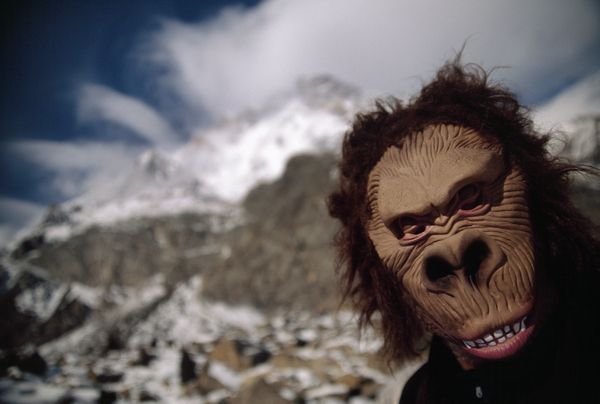
Bryan Sykes, a respected geneticist at Oxford University in the U.K., this week reported the findings of a yearlong project that aimed to rigorously test hair and tissue samples that were claimed to have belonged to the elusive creature.
"I put out a call for Yeti, Bigfoot, and Sasquatch hairs in 2012, and I received a good response from all over the world," Sykes told NBC News.
One of the most promising samples that Sykes received included hairs attributed to a Yeti mummy in the northern Indian region of Ladakh; the hairs were purportedly collected by a French mountaineer who was shown the corpse 40 years ago. Another sample was a single hair that was found about a decade ago in Bhutan, some 800 miles (1,290 kilometers) away from Ladakh.
According to Sykes, the DNA from these two samples matched the genetic signature of a polar bear jawbone that was found in the Norwegian Arctic in 2004. Scientists say the jawbone could be up to 120,000 years old.
Sykes's findings will be the focus of Bigfoot Files, a documentary series premiering on Britain's Channel 4 this Sunday. (A two-hour special will air in the U.S. on Sunday, November 17, at 8:00 p.m. ET/PT on the National Geographic Channel.)
Still Alive?
Sykes said the fact that the hair samples were found so far apart, and relatively recently, suggests the species that the hairs came from may still be alive.
"I can't imagine we managed to get samples from the only two 'snow bears' in the Himalayas," he told the Associated Press.
Sykes speculated that the creature could be a new bear species, or perhaps a hybrid of polar bears and brown bears.
"The next thing is [to] go there and find one," Sykes told the Associated Press.
Loren Coleman, director of the International Cryptozoology Museum in Portland, Maine, said Sykes's finding could be the "number one story in cryptozoology" - the study of hidden, or unverified, animals - "for the decade."
Coleman, who also appears in the upcoming documentary, said he thinks Sykes's findings likely explain only one of the Yeti varieties that have been reported.
"That's one of the problems with the word 'Yeti,'" Coleman said. "It's an umbrella term for three different varieties. There's the small kind, there's a man-sized type, and then a larger one that is known as Dzu-Teh. I must assume what he's looking at are samples from the larger-sized one that many of us in the field have speculated was a form of bear."
If, as Sykes's findings suggest, the Dzu-Teh is indeed the same species of early polar bear that once roamed the Arctic, it is unlikely to have a white fur coat, as often shown in popular depictions of the Yeti, since it was one of the first polar bears to branch off from brown bears.
That, Coleman said, actually strengthens Sykes's case that the larger Yeti is an ancient polar bear species.
"It's one of the myths of the Abominable Snowman and Yeti that they're white," Coleman said.
"The native people actually describe them as brown and reddish-brown."
Conceivable
Brian Regal, a science historian at Kean University in New Jersey, called the possibility of an unidentified bear species living in the Himalayas "exciting," but said it will be difficult to definitively connect the hairs to the Yeti of legend.
"This is another disappointment for the cryptozoology community," Regal said. "Just because [Sykes] showed that this particular DNA sample is from a bear doesn't necessarily mean that's what people have been seeing. They may have been seeing bears; they may have been seeing something else."
Biologist Robert Rockwell, who has studied polar bears, said he thinks it's conceivable that a bear species has managed to survive in the Himalayas unnoticed.
"It is possible, as Asiatic black bears, brown bears, and even sun bears - or some odd combination - conceivably could or could have historically been in that general region. Since they are [bears], they too would share a lot of the DNA sequences found in the fossil cited," said Rockwell, who is at the American Museum of Natural History in New York.
"Could something like that be in that area and not be seen clearly or captured or collected? It is a huge area, much of which is not densely populated, and except for increasingly habituated individuals, most [bears] are pretty shy. And if there are not many of them, it is even more conceivable."
Need for Peer Review
But Rockwell said he will need to see Sykes's results published in a peer-reviewed scientific journal before he is convinced the hair samples indeed came from bears.
"The claim is based on a really small sample, and the DNA is likely degraded to some extent. Until the sequence data have been published, I am going to be rather skeptical," Rockwell said.
"So many critters share so much of their DNA that getting 'matches' can be an artifact of sampling and will certainly depend on precisely what region of DNA is being used."
Molecular biologist Charlotte Lindqvist expressed a similar sentiment. "I'd like to see the data published and scrutinized," said Lindqvist, who is with the State University of New York's University at Buffalo. She was part of the team that extracted DNA from the ancient polar bear jawbone that Sykes used in his genetic comparisons.
"Before that happens, it makes little sense to me to suggest any links between the 120,000-year-old polar bear and a bear (or Yeti) in the Himalayas," Lindqvist said in an email.
Sykes says he intends to publish his findings. "The project is still going on," he told NBC News, "and the idea is to publish these results in a scientific journal to bring it back into the realm of science."



Reader Comments
to our Newsletter